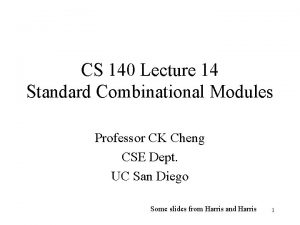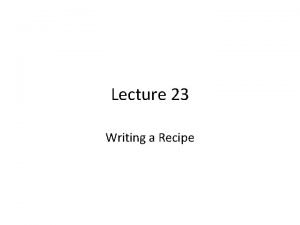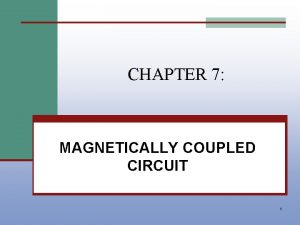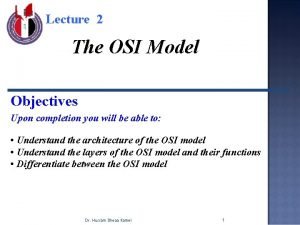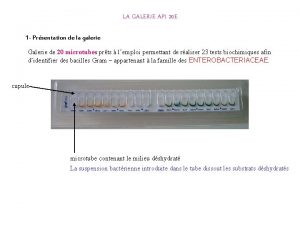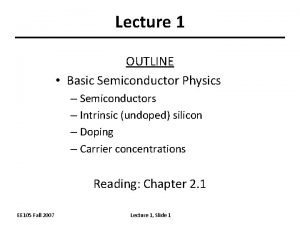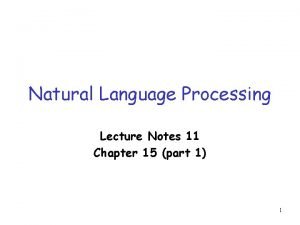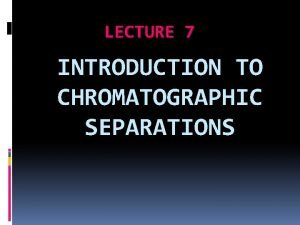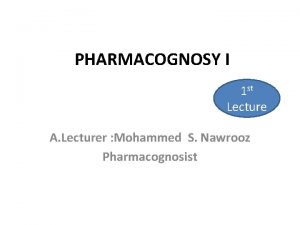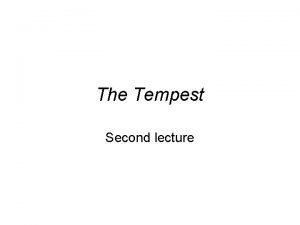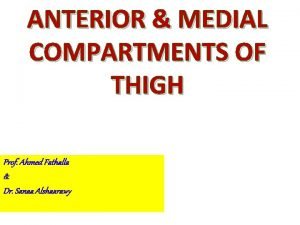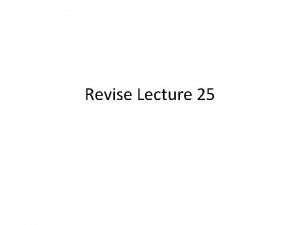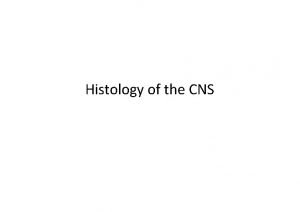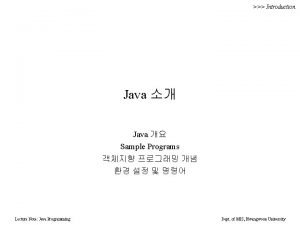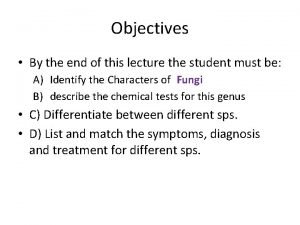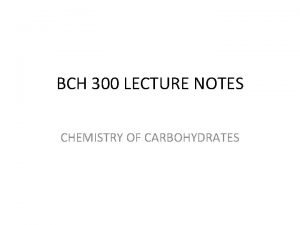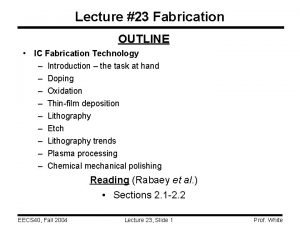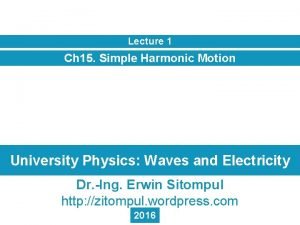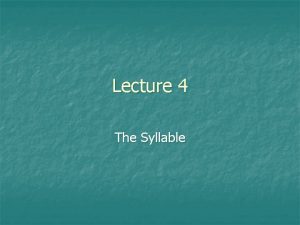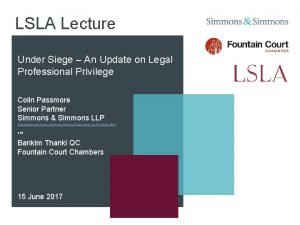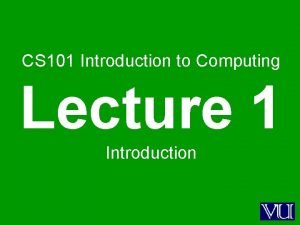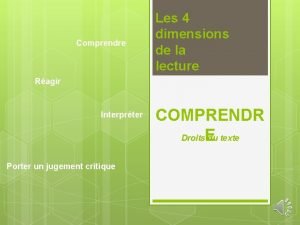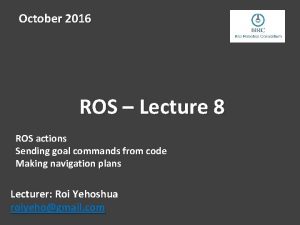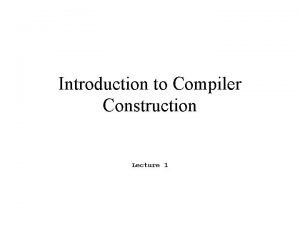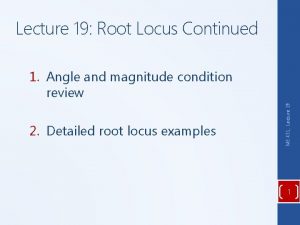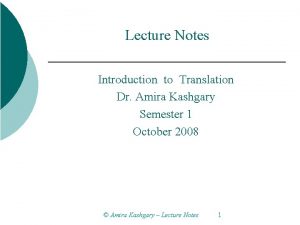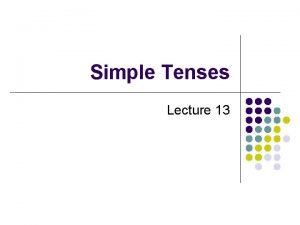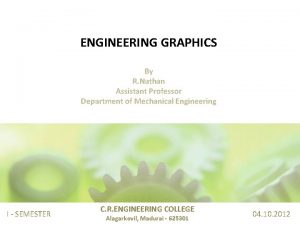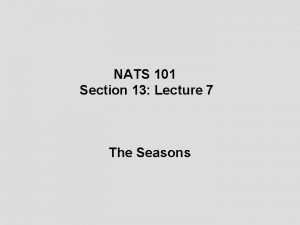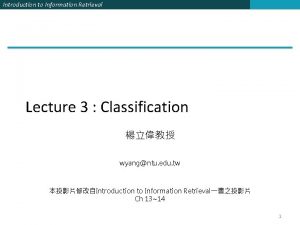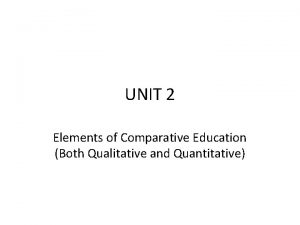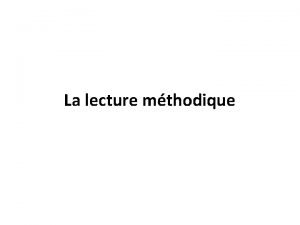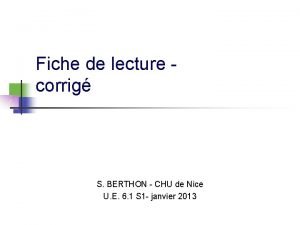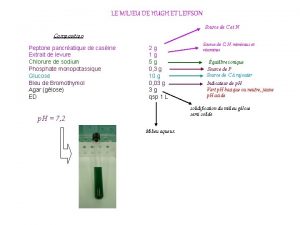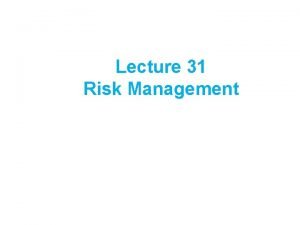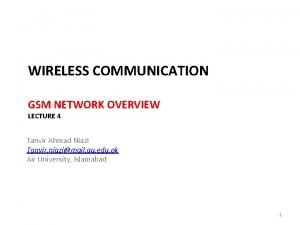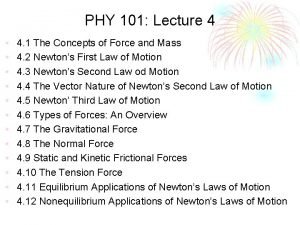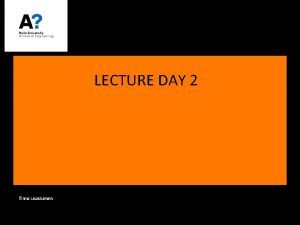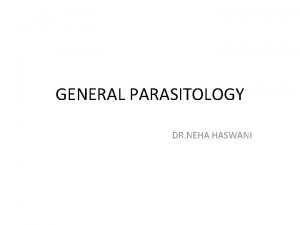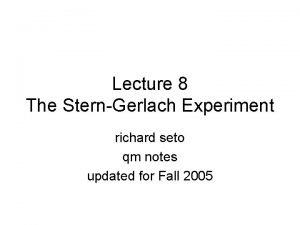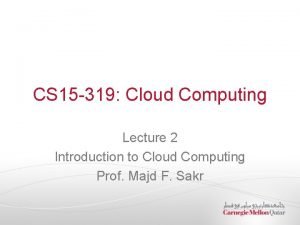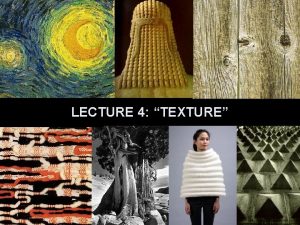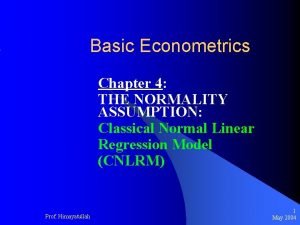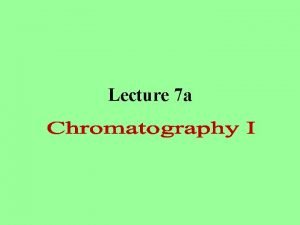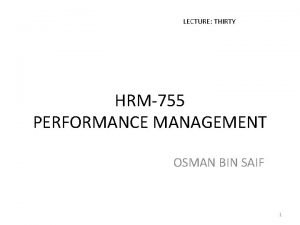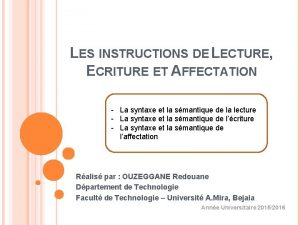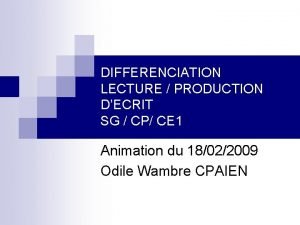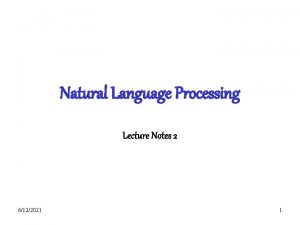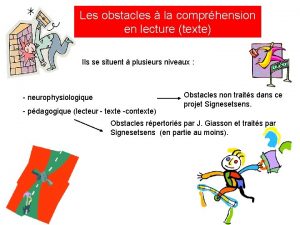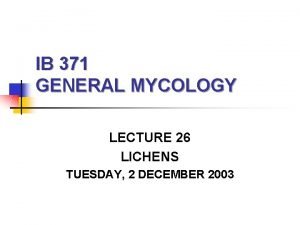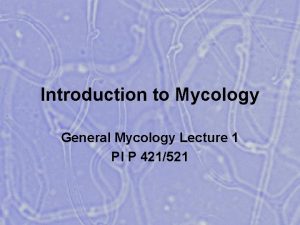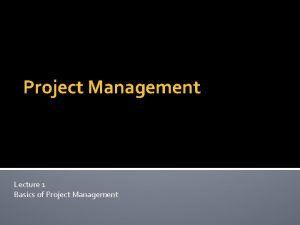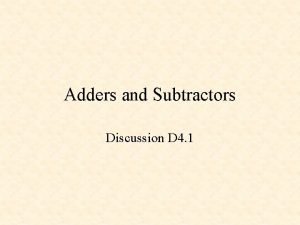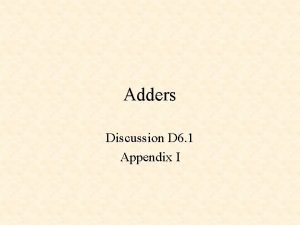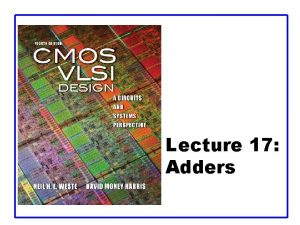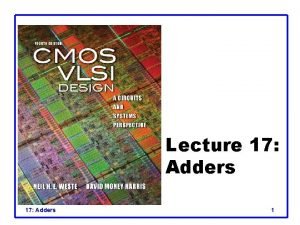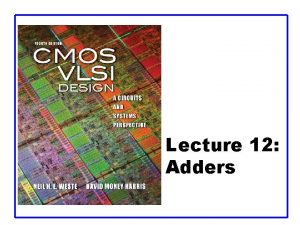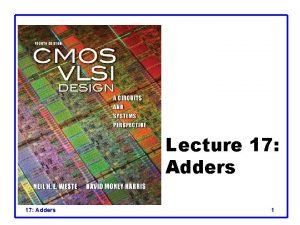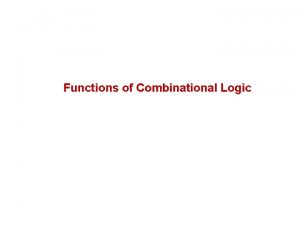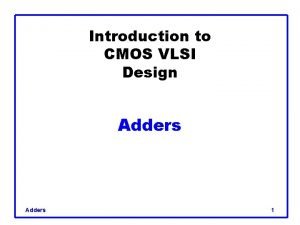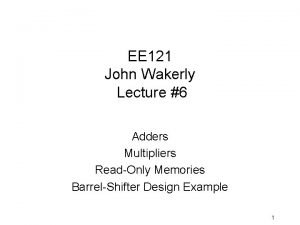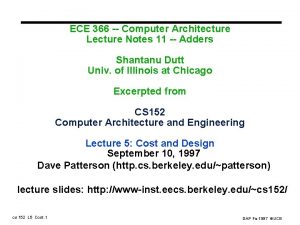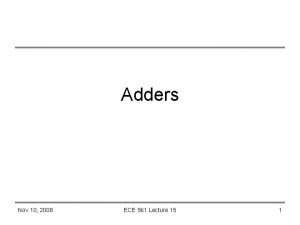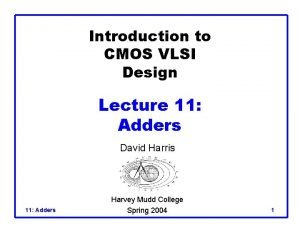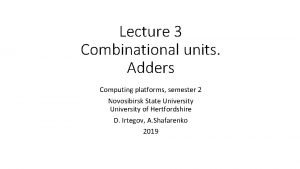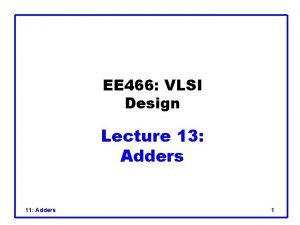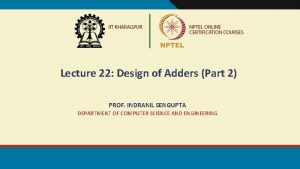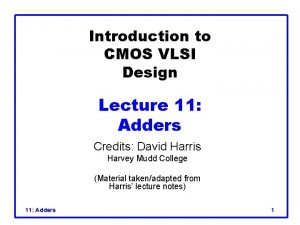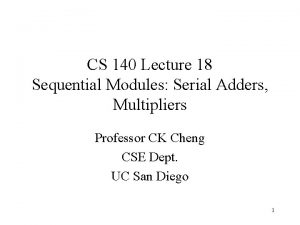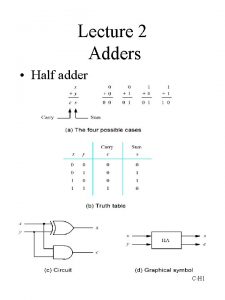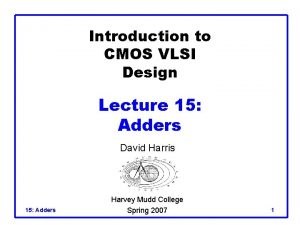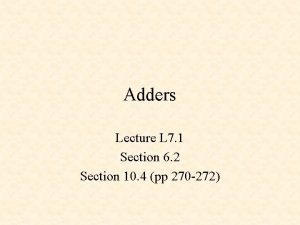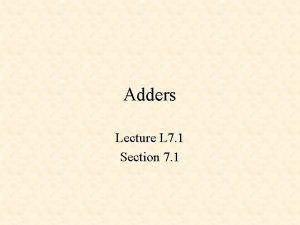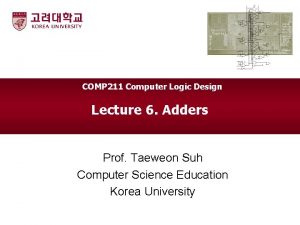Lecture 17 Adders Outline q q q q









































































































































![Knowles [2, 1, 1, 1] 17: Adders CMOS VLSI Design 4 th Ed. 138 Knowles [2, 1, 1, 1] 17: Adders CMOS VLSI Design 4 th Ed. 138](https://slidetodoc.com/presentation_image_h/e5efdf22492bfd5d018944a98877a8b2/image-138.jpg)






















- Slides: 160

Lecture 17: Adders

Outline q q q q q Datapath Computer Arithmetic Principles Single-bit Addition Carry-Ripple Adder Carry-Skip Adder Carry-Lookahead Adder Carry-Select Adder Carry-Increment Adder Tree Adder 17: Adders CMOS VLSI Design 4 th Ed. 2

A Generic Digital Processor 17: Adders CMOS VLSI Design 4 th Ed. 3

Building Blocks for Digital Architectures q Arithmetic unit – Bit sliced data path – adder, multiplier, shifter, comparator, etc. q Memory – RAM, ROM, buffers, shift registers q Control – Finite state machine (PLA, random logic) – Counters q Interconnect – Switches, arbiters, bus 17: Adders CMOS VLSI Design 4 th Ed. 4

An Intel Microprocessor 17: Adders CMOS VLSI Design 4 th Ed. 5

Bit-Sliced Design 17: Adders CMOS VLSI Design 4 th Ed. 6

Bit-Sliced Datapath 17: Adders CMOS VLSI Design 4 th Ed. 7

Itanium Integer Datapath 17: Adders CMOS VLSI Design 4 th Ed. 8

Motivation q Arithmetic units are, among others, core of every data path and addressing unit. q Data path is at the core of – microprocessors (CPU) – signal processors (DSP) – data processing application specific IC’s (ASIC) and programmable IC’s (FPGA) q Standard arithmetic units available from libraries q Design of arithmetic units necessary for – non-standard operations – high performance components – library development 17: Adders CMOS VLSI Design 4 th Ed. 9

Naming Conventions q Signal busses: A (1 -D), Ai, (2 -D), ai: k (sub-bus, 1 -D) q Signals: a, ai (1 -D), ai, k (2 -D), Ai: k (group signal) q Circuit complexity measures: A (Area), T (cycle time, delay), AT (area-time product), L (latency, number of cycles). q Arithmetic operators: +, -, • , /, log (=log 2) q Logic operators: OR, AND, XOR, NOT, … 17: Adders CMOS VLSI Design 4 th Ed. 10

Circuit Complexity Measures q Unit gate model – Inverter, buffer: A = 0, T = 0 – Simple monotonic 2 -input gates (AND, OR, NAND, NOR): A = 1, T = 1 – Simple non-monotonic 2 -input gates (XOR, XNOR): A = 2, T = 2 – Simple m-input gates: A = m – 1, T = – Wiring not considered – Only for estimation purposes 17: Adders CMOS VLSI Design 4 th Ed. 11

Recursive Function Evaluation q Given: inputs ai, outputs zi, function f (graph sym. • ) q Non-recursive functions (n. ) – Output zi is a function of input ai – Parallel structure 17: Adders CMOS VLSI Design 4 th Ed. 12

Recursive Function Evaluation q Recursive functions (r. ) – Output zi is a function of all inputs ak, k ≤ i • with a single output z = zn-1 (r. s. ): – f is non-associative (r. s. n) » serial structure – f is associative (r. s. a) » serial or single-tree structure 17: Adders CMOS VLSI Design 4 th Ed. 13

Recursive Function Evaluation – Output zi is a function of all inputs ak, k ≤ i • multiple outputs zi (r. m. ) (=> prefix problem) – f is non-associative (r. m. n) » serial structure – f is associative (r. m. a) » Serial or multi-tree structure » Shared tree structure 17: Adders CMOS VLSI Design 4 th Ed. 14

Arithmetic Operations q Overview 17: Adders CMOS VLSI Design 4 th Ed. 15

Overview of Arithmetic Operations q Direct implementation of dedicated units – always: 1 – 5 – in most cases: 6 – sometimes: 7, 8 q Sequential implementation using simpler units and several clock cycles (decomposition) – sometimes: 6 – in most cases: 7, 8, 9 q Table look-up techniques using ROMs – universal: simple application to all operations – efficient only for single-operand operations of high complexity (8 - 12) and small word length. 17: Adders CMOS VLSI Design 4 th Ed. 16

Overview of Arithmetic Operations q Approximation using simpler units: 7 – 12 – Taylor series expansion – polynomial and rational approximations – convergence of recursive equation systems – CORDIC (COordinate Rotation DIgital Computer) 17: Adders CMOS VLSI Design 4 th Ed. 17

Binary Number Systems q Radix-2, binary number system (BNS): irredundant, weighted, positional, monotonic. q n-bit number is an ordered sequence of bits (binary digits) q Simple and efficient implementation in digital circuits q MSB/LSB (most/least significant bit): an-1/a 0 q Represents an integer or fixed point number, exact. q Fixed point numbers: m-bit integer 17: Adders n-m bit fraction CMOS VLSI Design 4 th Ed. 18

Binary Number Systems q Unsigned: positive or natural numbers – Value: – Range: q Two’s (2’s) complement: standard representation of signed or integer numbers – Value – Range 17: Adders CMOS VLSI Design 4 th Ed. 19

Binary Number Systems – Complement: – Sign: an-1 – Properties: asymmetric range, compatible with unsigned numbers in many arithmetic operations. (same treatment of positive and negative numbers) q One’s (1’s) complement: similar to 2’s complement – Value: – Range: 17: Adders CMOS VLSI Design 4 th Ed. 20

Binary Number Systems – Complement: – Sign: an-1 – Properties: double representation of zero, symmetric range, modulo (2 n-1) number system. q Sign-magnitude: alternative representation of signed numbers – Value: – Range: – Complement: 17: Adders CMOS VLSI Design 4 th Ed. 21

Binary Number Systems q Sign: an-1 q Properties: double representation of zero, symmetric range, different treatment of positive and negative numbers in arithmetic operations, no MSB toggles at sign changes around 0 (=> low power) 17: Adders CMOS VLSI Design 4 th Ed. 22

Gray Numbers q Gray numbers (code): binary, irredundant, nonweighted, non-monotonic. – Property: unit-distance coding. Exactly one-bit toggles between adjacent numbers. – Applications: counters with low output toggle rate (low power busses), representation of continuous signals for low-error sampling (no false numbers due to switching of different bits at different times). – Non-monotonic numbers: difficult arithmetic operations (addition, comparison). 17: Adders CMOS VLSI Design 4 th Ed. 23

Gray Numbers – Binary - Gray conversion – Gray – binary conversion 17: Adders CMOS VLSI Design 4 th Ed. 24

Redundant Number Systems q Non-binary, redundant, weighted number systems. q Digit set larger than radix (typically radix 2) => multiple representations of the same number => redundancy. q No carry propagation in adders => more efficient implementation of adder-based units (multipliers, dividers, etc. ) q Redundancy => no direct implementation of relational operators => conversion to irredundant numbers. q Several bits used to represent one digit => higher storage requirements. q Expensive conversion to irredundant numbers. Not necessary if redundant input operators are allowed. 17: Adders CMOS VLSI Design 4 th Ed. 25

Delayed-Carry Representation q Delayed-carry or half adder representation q 1 digit holds the sum of 2 bits (no carry out) q Example: 01 + 01 = (0, 0) (1, 0) = 2 17: Adders CMOS VLSI Design 4 th Ed. 26

Carry-Save Representation q One digit holds the sum of 3 bits or 1 digit and 1 bit. No carry-out digit, carry is saved. q Standard redundant number system for fast addition. 17: Adders CMOS VLSI Design 4 th Ed. 27

Signed-Digit Representation q Signed-digit (SD) or redundant digit (RD) number representation. q No carry propagation in S = R + T q One digit holds the sum of two digits. No carry-out. 17: Adders CMOS VLSI Design 4 th Ed. 28

Signed-Digit Representation q Minimal SD representation: minimal number of nonzero digits. – Applications: sequential multiplication (less cycles), filters with constant coefficients (less hardware). – Example: minimal 17: Adders CMOS VLSI Design 4 th Ed. 29

Signed-Digit Representation q Canonical SD representation: minimal SD. Not two non-zero digits in sequence. q SD -> binary: carry propagation necessary => adder. q Other applications: high speed multipliers. q Similar to carry-save, simple use for signed numbers. 17: Adders CMOS VLSI Design 4 th Ed. 30

Residue Number Systems q Non-binary, irredundant, non-weighted number system. q Carry-free and fast additions and multiplications. q Complex and slow other arithmetic operations (e. g. comparison, sign, and overflow detection) because digits are not weighted. Conversion to weighted mixed-radix or binary system required. q Codes for error correction and detection. q Possible applications (but hardly used) – Digital filters – Error detection and correction 17: Adders CMOS VLSI Design 4 th Ed. 31

Residue Number Systems q Base is n-tuple of integers (mn-1, mn-2, …, m 0), residues (or moduli). These mi are pairwise prime. q Arithmetic operations: each digit computed separately. 17: Adders CMOS VLSI Design 4 th Ed. 32

Residue Number Systems q Best moduli mi are 2 k and 2 k – 1. – High storage efficiency with k bits. – Simple modular addition k bit adder without cout 17: Adders CMOS VLSI Design 4 th Ed. 33

Residue Number Systems q Example: 17: Adders CMOS VLSI Design 4 th Ed. 34

Floating-Point Numbers q Larger range, smaller precision than fixed-point representation, inexact, real numbers. q Double-number form => discontinuous precision. q S | biased exponent E | unsigned norm mantissa M q Basic arithmetic operations 17: Adders CMOS VLSI Design 4 th Ed. 35

Floating-Point Numbers q Basic arithmetic operations based in fixed point add, multiply, and shift operations. Post-normalization required. q Applications: – Processors: real floating point formats (e. g. IEEE standard), large range due to universal use. – ASICs: usually simplified floating-point formats with small exponents, smaller range. Used for range extension of normal fixed-point numbers. q IEEE floating point format: 17: Adders CMOS VLSI Design 4 th Ed. 36

Logarithmic Number System q Alternative representation to floating point (mantissa + integer exponent -> only fixed point exponent). q Single number form => continuous precision => higher accuracy, more reliable. q Basic arithmetic operations: – (A < B) = (EA < EB) additionally consider sign – A + B by approximation or addition in conventional number system and double conversion. 17: Adders CMOS VLSI Design 4 th Ed. 37

Logarithmic Number System q Basic arithmetic operations – Simpler multiplication, exponentiation. More complex addition. – Expensive conversion: (anti)logarithms probably by table look-up. – Applications: real-time digital filters. 17: Adders CMOS VLSI Design 4 th Ed. 38

Antitetrational Number System q Tetration (t. x = and antitetration (a. t. x) q Larger range, but smaller precision than logarithmic representation. Otherwise, analogous. q Note that all these systems can be mixed in composite arithmetic. q Choice of number representation should be hidden from the user. The compiler should handle it. q Rational numbers can also be represented in floating slash notation. 17: Adders CMOS VLSI Design 4 th Ed. 39

Round-Off Schemes q Intermediate results with d additional lower bits. This results in higher accuracy. q Rounding: keeping error e small during final word length reduction: q Trade-off: numerical accuracy vs implementation cost. q Truncation – = average error e q Round to nearest (normal rounding) 17: Adders CMOS VLSI Design 4 th Ed. 40

Round-Off Schemes q Round to nearest – The error is nearly symmetric – + 0. 12 can often be included in a previous operation. q Round to nearest even/odd – bias = 0 (symmetric) – Mandatory in IEEE floating-point standard q 3 guard bits for rounding after floating point operations: guard bit G (postnormalization), round bit R (round to nearest ), sticky bit S (round to nearest even) 17: Adders CMOS VLSI Design 4 th Ed. 41

Addition 17: Adders CMOS VLSI Design 4 th Ed. 42

Single-Bit Addition Half Adder Full Adder A B Cout S A B C Cout S 0 0 0 0 0 1 0 0 1 1 0 0 1 1 1 0 0 0 1 1 0 1 1 17: Adders CMOS VLSI Design 4 th Ed. 43

1 -Bit Adders q Add up m bits of same magnitude q Output the sum as a k-bit number ( q Or count 1’s at inputs => (m, k) counter – combinational counter. q A half adder is a (2, 2) counter 17: Adders CMOS VLSI Design 4 th Ed. ) 44

1 -Bit Adders 17: Adders CMOS VLSI Design 4 th Ed. 45

1 -Bit Adders q A full-adder is a (3, 2) counter. 17: Adders CMOS VLSI Design 4 th Ed. 46

PGK q For a full adder, define what happens to carries (in terms of A and B) – Generate: Cout = 1 independent of C • G=A • B – Propagate: Cout = C • P=A B – Kill: Cout = 0 independent of C • K = ~A • ~B 17: Adders CMOS VLSI Design 4 th Ed. 47

Full Adder Design I q Brute force implementation from eqns 17: Adders CMOS VLSI Design 4 th Ed. 48

Full Adder Design II q Factor S in terms of Cout S = ABC + (A + B + C)(~Cout) q Critical path is usually C to Cout in ripple adder 17: Adders CMOS VLSI Design 4 th Ed. 49

Full Adder Design II q Same circuit with sized transistors 17: Adders CMOS VLSI Design 4 th Ed. 50

Layout q Clever layout circumvents usual line of diffusion – Use wide transistors on critical path – Eliminate output inverters 17: Adders CMOS VLSI Design 4 th Ed. 51

Full Adder Design III q Complementary Pass Transistor Logic (CPL) – Slightly faster, but more area 17: Adders CMOS VLSI Design 4 th Ed. 52

Full Adder Design III q Transmission gates 17: Adders CMOS VLSI Design 4 th Ed. 53

Full Adder Design IV q Dual-rail domino – Very fast, but large and power hungry – Used in very fast multipliers 17: Adders CMOS VLSI Design 4 th Ed. 54

(m, k) Counters q Usually built from full-adders. q Associativity of addition allows conversion from linear to tree structure => faster at the same number of FAs. 17: Adders CMOS VLSI Design 4 th Ed. 55

(7, 3) Counter q Example 17: Adders CMOS VLSI Design 4 th Ed. 56

Carry Propagate Adders q Add two n-bit operands A and B and an optional carry in cin by performing carry propagation. q Sum (cout, S) is an irredundant (n+1) bit number 17: Adders CMOS VLSI Design 4 th Ed. 57

Carry Propagate Adders q N-bit adder called CPA – Each sum bit depends on all previous carries – How do we compute all these carries quickly? 17: Adders CMOS VLSI Design 4 th Ed. 58

Ripple-Carry Adder(RCA) q Serial arrangement of n full adders. q Simplest, smallest, and slowest CPA structure. 17: Adders CMOS VLSI Design 4 th Ed. 59

Carry-Ripple Adder q Simplest design: cascade full adders – Critical path goes from Cin to Cout – Design full adder to have fast carry delay 17: Adders CMOS VLSI Design 4 th Ed. 60

Carry Ripple Adder q Note that worst case delay is linear with number of bits. q Goal: Make the fastest possible carry path circuit. 17: Adders CMOS VLSI Design 4 th Ed. 61

A Full Adder Circuit 17: Adders CMOS VLSI Design 4 th Ed. 62

Inversion Property 17: Adders CMOS VLSI Design 4 th Ed. 63

Inversions q Critical path passes through majority gate – Built from minority + inverter – Eliminate inverter and use inverting full adder 17: Adders CMOS VLSI Design 4 th Ed. 64

Mirror Adder 17: Adders CMOS VLSI Design 4 th Ed. 65

Mirror Adder 17: Adders CMOS VLSI Design 4 th Ed. 66

Mirror Adder q The NMOS and PMOS chains are completely symmetrical. A maximum of two series transistors can be observed in the carry generation circuit. q When laying out the cell, the most critical issue is the minimization of the capacitance at node Co. The reduction of the diffusion capacitances is particularly important. q The capacitance at node Co is composed of four diffusion capacitances, two internal gate capacitances, and six gate capacitances in the connecting adder cell. 17: Adders CMOS VLSI Design 4 th Ed. 67

Mirror Adder q The transistors connected to Ci are placed closest to the input. q Only the transistors in the carry stage have to be optimized for optimal speed. All transistors in the sum stage can be minimal size. 17: Adders CMOS VLSI Design 4 th Ed. 68

Transmission Gate FA 17: Adders CMOS VLSI Design 4 th Ed. 69

Carry Propagation Speed-up q Concatenation of partial CPA’s with fast cin -> cout. q Fast carry look-ahead logic for entire range of bits. 17: Adders CMOS VLSI Design 4 th Ed. 70

Generate / Propagate q Equations often factored into G and P q Generate and propagate for groups spanning i: j q Base case q Sum: 17: Adders CMOS VLSI Design 4 th Ed. 71

PG Logic 17: Adders CMOS VLSI Design 4 th Ed. 72

PG Logic 17: Adders CMOS VLSI Design 4 th Ed. 73

Carry-Ripple Revisited 17: Adders CMOS VLSI Design 4 th Ed. 74

Carry-Ripple PG Diagram 17: Adders CMOS VLSI Design 4 th Ed. 75

PG Diagram Notation 17: Adders CMOS VLSI Design 4 th Ed. 76

Manchester Carry Chain 17: Adders CMOS VLSI Design 4 th Ed. 77

Manchester Carry Chain 17: Adders CMOS VLSI Design 4 th Ed. 78

Manchester Carry Chain 17: Adders CMOS VLSI Design 4 th Ed. 79

Carry-Skip Adder q Carry-ripple is slow through all N stages q Carry-skip allows carry to skip over groups of n bits – Decision based on n-bit propagate signal 17: Adders CMOS VLSI Design 4 th Ed. 80

Carry-Skip Adder 17: Adders CMOS VLSI Design 4 th Ed. 81

Carry-Skip Adder 17: Adders CMOS VLSI Design 4 th Ed. 82

Carry-Skip Adder 17: Adders CMOS VLSI Design 4 th Ed. 83

Carry-Skip PG Diagram For k n-bit groups (N = nk) 17: Adders CMOS VLSI Design 4 th Ed. 84

Variable Group Size Delay grows as O(sqrt(N)) 17: Adders CMOS VLSI Design 4 th Ed. 85

Carry-Skip Adder q Partial CPA with fast ck -> ci q If Pi-1: k = 0 : ck does not become c’i and c’i is selected, becoming ci. q If Pi-1: k = 0 : ck becomes c’i, but c’i is skipped. q Path ck -> c’i -> ci never sensitized => fast ck -> ci q False path => inherent logic redundancy => problems in circuit optimization, timing analysis, and testing. 17: Adders CMOS VLSI Design 4 th Ed. 86

Carry-Skip Adder q Variable group sizes are faster. – Use larger groups in the middle – Minimize delays a 0 -> ck -> si-1 and ak -> ci -> sn-1 q Partial CPA type is RCA or CSKA (multilevel CSKA) q Medium speed-up at small hardware overhead (+ AND/bit +MUX/group) 17: Adders CMOS VLSI Design 4 th Ed. 87

CSKA + Manchester 17: Adders CMOS VLSI Design 4 th Ed. 88

Carry-Select Adder q Trick for critical paths dependent on late input X – Precompute two possible outputs for X = 0, 1 – Select proper output when X arrives q Carry-select adder precomputes n-bit sums – For both possible carries into n-bit group 17: Adders CMOS VLSI Design 4 th Ed. 89

Carry-Select Adder q Partial CPA with fast ck -> ci and ck -> si-1: k q Two CPA’s compute two possible results (cin = 0/1), group carry-in ck selects correct one afterwards. q Variable group sizes are faster; use larger groups at end (MSB). Balance delays a 0 -> ck and ak -> ci 0 q Partial CPA type is RCA, CSLA (multilevel CSLA) or CLA. 17: Adders CMOS VLSI Design 4 th Ed. 90

Carry-Select Adder q High speed-up at high hardware overhead. – + MUX/bit + (CPA + MUX)/group 17: Adders CMOS VLSI Design 4 th Ed. 91

Carry-Select Adder 17: Adders CMOS VLSI Design 4 th Ed. 92

Carry-Select Adder 17: Adders CMOS VLSI Design 4 th Ed. 93

Linear Carry-Select 17: Adders CMOS VLSI Design 4 th Ed. 94

Square-Root Carry-Select 17: Adders CMOS VLSI Design 4 th Ed. 95

Delay Comparison 17: Adders CMOS VLSI Design 4 th Ed. 96

Carry-Increment Adder q Partial CPA with fast ck -> ci and ck -> si-1: k q Result is incremented after addition if ck = 1 q Variable group sizes are faster, use larger groups at end (MSB). Balance delays a 0 -> ck and ak -> c’i q Partial CPA could be RCA, CIA (multilevel CIA) or CLA. q High speed-up at medium hardware overhead (+AND/bit + (incrementer + AND/OR)/group). q Logic of CPA and incrementer could be merged. 17: Adders CMOS VLSI Design 4 th Ed. 97

Carry-Increment Adder 17: Adders CMOS VLSI Design 4 th Ed. 98

Carry-Increment Adder q Example: gate-level schematic of carry-increment adder (CIA) – Only two different logic cells (bit-slices): IHA and IFA 17: Adders CMOS VLSI Design 4 th Ed. 99

Carry-Increment Adder q Factor initial PG and final XOR out of carry-select 17: Adders CMOS VLSI Design 4 th Ed. 100

Variable Group Size q Also buffer noncritical signals 17: Adders CMOS VLSI Design 4 th Ed. 101

Conditional-Sum Adder q Optimized multilevel CSLA with logn levels q Correct sum bits or are conditionally selected through logn levels of multiplexers. q Bit groups of size 2 l at level l. q Higher parallelism, more balanced signal paths. q Highest speed-up at highest hardware overhead (2 RCA + more than logn MUX/bit) 17: Adders CMOS VLSI Design 4 th Ed. 102

Conditional-Sum Adder 17: Adders CMOS VLSI Design 4 th Ed. 103

Conditional-Sum Adder 17: Adders CMOS VLSI Design 4 th Ed. 104

Conditional-Sum Adder 17: Adders CMOS VLSI Design 4 th Ed. 105

Carry-Lookahead Adder q Carries look ahead before sum bits are computed q Hierarchical arrangement using levels: passed up, c’ 0 passed down between levels. q High speed-up at medium hardware overhead. 17: Adders CMOS VLSI Design 4 th Ed. 106

Carry-Lookahead Adder 17: Adders CMOS VLSI Design 4 th Ed. 107

Carry-Lookahead Adder 17: Adders CMOS VLSI Design 4 th Ed. 108

Carry-Lookahead Adder q Carry-lookahead adder computes Gi: 0 for many bits in parallel. q Uses higher-valency cells with more than two inputs. 17: Adders CMOS VLSI Design 4 th Ed. 109

CLA PG Diagram 17: Adders CMOS VLSI Design 4 th Ed. 110

Carry-Lookahead 17: Adders CMOS VLSI Design 4 th Ed. 111

Lookahead Tree 17: Adders CMOS VLSI Design 4 th Ed. 112

Lookahead Tree 17: Adders CMOS VLSI Design 4 th Ed. 113

Higher-Valency Cells 17: Adders CMOS VLSI Design 4 th Ed. 114

Higher Valency PG Diagram 17: Adders CMOS VLSI Design 4 th Ed. 115

Tree Adder q If lookahead is good, lookahead across lookahead! – Recursive lookahead gives O(log N) delay q Many variations on tree adders 17: Adders CMOS VLSI Design 4 th Ed. 116

Parallel Prefix Adders q Universal adder architecture comprising RCA, CIA, CLA, and more (entire range of area-delay trade-offs from slowest RCA to fastest CLA). q Preprocessing, carry-lookahead, and postprocessing step. q Carries calculated using parallel-prefix algorithms – High regularity: suitable for synthesis and layout – High flexibility: special adders, other arthmetic operations, exchangeable prefix algorithms. – High performance: smallest and fastest adders 17: Adders CMOS VLSI Design 4 th Ed. 117

Parallel Prefix Adders 17: Adders CMOS VLSI Design 4 th Ed. 118

Prefix Problem q Inputs (xn-1, …, x 0) outputs (yn-1, …, y 0), associative binary operator • q Associativity of • => tree structures for evaluation 17: Adders CMOS VLSI Design 4 th Ed. 119

Prefix Problem q Group variables : covers bits (xk, …, xi) at level l. q Carry-propagation is prefix problem: q Parallel-prefix algorithms: – Multi-tree structures T = O(n) -> O(logn) – Sharing subtrees A = O(n 2) -> O(nlogn) – Different algorithms trading area vs delay. Also consider wirng and fanout. 17: Adders CMOS VLSI Design 4 th Ed. 120

Prefix Algorithms q Algorithms visualized by directed acyclic graphs (DAG) with array structure (n bits x m levels). q Graph vertex symbols q Performance measures: – A • : graph size (number of black nodes) – T • : graph depth (number of black nodes on critical path) 17: Adders CMOS VLSI Design 4 th Ed. 121

Prefix Algorithms q Serial prefix algorithm (RCA) 17: Adders CMOS VLSI Design 4 th Ed. 122

Prefix Algorithms q Sklansky parallel-prefix algorithm (PPA-SK) – Tree-like collection, parallel redistribution of carries 17: Adders CMOS VLSI Design 4 th Ed. 123

Sklansky 17: Adders CMOS VLSI Design 4 th Ed. 124

Prefix Algorithms q Brent-Kung parallel-prefix algorithm (PPA-BK) – Traditional CLA is PPA-BK with 4 -bit groups – Tree-like redistribution of carries (fan-out tree) 17: Adders CMOS VLSI Design 4 th Ed. 125

Brent-Kung 17: Adders CMOS VLSI Design 4 th Ed. 126

Prefix Algorithms q Kogge-Stone parallel-prefix algorithm (PPA-KS) – very high wiring requirements 17: Adders CMOS VLSI Design 4 th Ed. 127

Kogge-Stone 17: Adders CMOS VLSI Design 4 th Ed. 128

Prefix Algorithms q Carry-increment parallel-prefix algorithm 17: Adders CMOS VLSI Design 4 th Ed. 129

Prefix Algorithms q Mixed serial/parallel-prefix algorithm (RCA+PPA) – Linear size-depth trade-off using parameter k: – k = 0 : serial prefix graph – : Brent-Kung parallel-prefix graph – Fills the gap between RCA and PPA-BK (CLA) in steps of single • -operations. 17: Adders CMOS VLSI Design 4 th Ed. 130

Prefix Algorithms 17: Adders CMOS VLSI Design 4 th Ed. 131

Prefix Algorithms q Example: 4 -bit PPA-SK – Efficient AND-OR-prefix circuit for the generate and AND-prefix circuit for the propagate signals – Optimization: alternatingly AOI/OAI- resp. NAND/NOR-gates (inverting gatesare smaller and faster). – Can also be realized using two MUX-prefix circuits 17: Adders CMOS VLSI Design 4 th Ed. 132

Prefix Algorithms 17: Adders CMOS VLSI Design 4 th Ed. 133

Prefix Algorithms q Prefix adders can be synthesized by human or computer as well. q Starting from a serial structure, one can use compression rules and expansion rules to obtain new graphs. q Can generate all previous graphs except PPA-KS. q Universal adder synthesis approach. 17: Adders CMOS VLSI Design 4 th Ed. 134

Tree Adder Taxonomy q Ideal N-bit tree adder would have – L = log N logic levels – Fanout never exceeding 2 – No more than one wiring track between levels q Describe adder with 3 -D taxonomy (l, f, t) – Logic levels: L+l – Fanout: 2 f + 1 – Wiring tracks: 2 t q Known tree adders sit on plane defined by l + f + t = L-1 17: Adders CMOS VLSI Design 4 th Ed. 135

Tree Adder Taxonomy 17: Adders CMOS VLSI Design 4 th Ed. 136

Han-Carlson 17: Adders CMOS VLSI Design 4 th Ed. 137
![Knowles 2 1 1 1 17 Adders CMOS VLSI Design 4 th Ed 138 Knowles [2, 1, 1, 1] 17: Adders CMOS VLSI Design 4 th Ed. 138](https://slidetodoc.com/presentation_image_h/e5efdf22492bfd5d018944a98877a8b2/image-138.jpg)
Knowles [2, 1, 1, 1] 17: Adders CMOS VLSI Design 4 th Ed. 138

Ladner-Fischer 17: Adders CMOS VLSI Design 4 th Ed. 139

Taxonomy Revisited 17: Adders CMOS VLSI Design 4 th Ed. 140

More Adder Issues q q Multilevel adders – Multilevel versions of adders possible • CSKA, CSLA, CIA Hybrid adders – Arbitrary combination of speed-up techniques possible. – Often used combinations: CLA – CSLA Transistor level adders – Influence of logic styles (dynamic logic, pass transistor logic) – Efficient transistor level implementation of ripple-carry chains (Manchester chain) – Combinations of speed-up techniques make sense. • Much higher design effort – Many efficient implementations exist in the literature. Higher valency (radix) also possible. 17: Adders CMOS VLSI Design 4 th Ed. 141

More Adder Issues q Higher valency is a poor choice in static CMOS logic since each stage has higher delay. q However, if the stages are built using domino logic, it could prove to be an advantage. q Nodes with large fanouts or long wires could use buffers. q The prefix trees can also be internally pipelined. 17: Adders CMOS VLSI Design 4 th Ed. 142

Transistor Level 17: Adders CMOS VLSI Design 4 th Ed. 143

Transistor Level 17: Adders CMOS VLSI Design 4 th Ed. 144

Transistor Level 17: Adders CMOS VLSI Design 4 th Ed. 145

Higher Valency Adders 17: Adders CMOS VLSI Design 4 th Ed. 146

Sparse Trees q Building a prefix tree to compute carries in every bit is expensive in terms of power. q An alternative is to compute carries into short groups such as s = 2, 3, 8, or 16 bits. q Meanwhile, pairs of s-bit adders precompute the sums assuming both carries-in of 0 and 1 to each group. q It is a hybrid between a prefix adder and carry select adder. 17: Adders CMOS VLSI Design 4 th Ed. 147

Valency-3 BK Adder q Sparse tree adder with s = 3 17: Adders CMOS VLSI Design 4 th Ed. 148

Carry-Select Implementation 17: Adders CMOS VLSI Design 4 th Ed. 149

Sparse Tree Adders q Intel Valency-2 Sklansky sparse tree adder with s=4 17: Adders CMOS VLSI Design 4 th Ed. 150

Sparse Tree Adders q Valency-3 Kogge-Stone sparse tree adder with s=3 17: Adders CMOS VLSI Design 4 th Ed. 151

Ling Adders q Ling discovered a technique to remove one series transistor from the critical group generate path at the expense of another XOR gate in the sum precomputation. q Define a pseudo-generate Hi: j = Gi + Gi-1: j This is a simpler computation. q Define a pseudo-propagate signal I that is a shifted version of propagate. 17: Adders CMOS VLSI Design 4 th Ed. 152

Ling Adders q Finally, the sums are computed by 17: Adders CMOS VLSI Design 4 th Ed. 153

Ling Adders 17: Adders CMOS VLSI Design 4 th Ed. 154

Comparison q Standard-cell implementation, 0. 8 mm technology 17: Adders CMOS VLSI Design 4 th Ed. 155

Comparison 17: Adders CMOS VLSI Design 4 th Ed. 156

Summary Adder architectures offer area / power / delay tradeoffs. Choose the best one for your application. Architecture Classification Logic Levels Max Fanout Tracks Cells Carry-Ripple N-1 1 1 N Carry-Skip n=4 N/4 + 5 2 1 1. 25 N Carry-Inc. n=4 N/4 + 2 4 1 2 N Brent-Kung (L-1, 0, 0) 2 log 2 N – 1 2 N Sklansky (0, L-1, 0) log 2 N N/2 + 1 1 0. 5 Nlog 2 N Kogge-Stone (0, 0, L-1) log 2 N 2 N/2 Nlog 2 N 17: Adders CMOS VLSI Design 4 th Ed. 157

E vs Delay Trade-off 17: Adders CMOS VLSI Design 4 th Ed. 158

E vs Delay Tradeoff 90 nm 64 bit domino KS Ling adder with various valency and s 17: Adders CMOS VLSI Design 4 th Ed. 159

Area vs Delay Synthesized Adders 17: Adders CMOS VLSI Design 4 th Ed. 160
 01:640:244 lecture notes - lecture 15: plat, idah, farad
01:640:244 lecture notes - lecture 15: plat, idah, farad Lecture outline example
Lecture outline example Lecture outline example
Lecture outline example Lecture outline example
Lecture outline example Lecture outline meaning
Lecture outline meaning Sentence outline example
Sentence outline example Process of research definition
Process of research definition Fundamental deviation table
Fundamental deviation table What is plagiarism
What is plagiarism Lecture 14
Lecture 14 Lecture recipe
Lecture recipe Magnetically coupled circuits lecture notes
Magnetically coupled circuits lecture notes Physics 102
Physics 102 Osi model lecture
Osi model lecture La galerie api 20e
La galerie api 20e Semiconductor lecture
Semiconductor lecture Lecture sound systems
Lecture sound systems C data types with examples
C data types with examples Lecture 101
Lecture 101 Pistil vs stamen
Pistil vs stamen Natural language processing lecture notes
Natural language processing lecture notes German adjectival nouns
German adjectival nouns Lecture automatique de questionnaires
Lecture automatique de questionnaires Requirement analysis in software engineering notes
Requirement analysis in software engineering notes Lecture title
Lecture title Analysis of algorithms lecture notes
Analysis of algorithms lecture notes Microbial physiology and metabolism lecture notes
Microbial physiology and metabolism lecture notes I was in hyderabad giving a lecture
I was in hyderabad giving a lecture Sargur srihari
Sargur srihari Atmospheric physics lecture notes
Atmospheric physics lecture notes Lecture on healthy lifestyle
Lecture on healthy lifestyle Introduction of chromatography
Introduction of chromatography Les objectifs de la lecture au primaire
Les objectifs de la lecture au primaire Objectif de lecture
Objectif de lecture Dsp lecture
Dsp lecture Unified health management information system
Unified health management information system Keeling curve
Keeling curve Intro to human resource management
Intro to human resource management Intermediate microeconomics lecture notes
Intermediate microeconomics lecture notes Customs in things fall apart
Customs in things fall apart Lecture flash
Lecture flash Sensitivity analysis lecture notes
Sensitivity analysis lecture notes Application of pharmacognosy
Application of pharmacognosy Reinforcement lap lengths eurocodes
Reinforcement lap lengths eurocodes Lymphatic system lecture
Lymphatic system lecture The tempest lecture
The tempest lecture Introduction to psychology lecture
Introduction to psychology lecture Anterior and medial compartment of thigh lecture
Anterior and medial compartment of thigh lecture Lecture villa dr najeeb
Lecture villa dr najeeb Feature of a cheque
Feature of a cheque Lecture name
Lecture name Cerebellar cortex
Cerebellar cortex Data mining lecture notes
Data mining lecture notes Neural networks and fuzzy logic
Neural networks and fuzzy logic Java sample code
Java sample code Phlebotomy lecture
Phlebotomy lecture Tolfnatate
Tolfnatate Principles of economics powerpoint lecture slides
Principles of economics powerpoint lecture slides Professor green lecture 1
Professor green lecture 1 Epimers of carbohydrates
Epimers of carbohydrates Exploratory data analysis lecture notes
Exploratory data analysis lecture notes La progression dramatique antigone
La progression dramatique antigone Ic fabrication technology
Ic fabrication technology Peter williams lecture theatre
Peter williams lecture theatre Goodrich method is used for
Goodrich method is used for Molecular cell biology lecture
Molecular cell biology lecture Social letters examples
Social letters examples Corporate governance lecture
Corporate governance lecture Simple harmonic motion lecture
Simple harmonic motion lecture Simpler syllables
Simpler syllables Human resource management lecture chapter 1
Human resource management lecture chapter 1 Advanced inorganic chemistry lecture notes
Advanced inorganic chemistry lecture notes Lecture announcement sample
Lecture announcement sample Lstm lecture
Lstm lecture Introduction to biochemistry lecture notes
Introduction to biochemistry lecture notes Slidetodoc.com
Slidetodoc.com Project planning and management lecture notes ppt
Project planning and management lecture notes ppt Siege lecture
Siege lecture English language lecture
English language lecture It 101 introduction to computing
It 101 introduction to computing La petite fille au kimono rouge questionnaire
La petite fille au kimono rouge questionnaire Define aerodynamics
Define aerodynamics Les 4 dimensions de la lecture
Les 4 dimensions de la lecture Roi yehoshua
Roi yehoshua If the lexical analyzer finds a token invalid then?
If the lexical analyzer finds a token invalid then? Tensorflow lecture
Tensorflow lecture Lecture 19
Lecture 19 Translate
Translate Genetic counseling definition
Genetic counseling definition Corneal reflex
Corneal reflex Lecture on tenses
Lecture on tenses Franck condon principle
Franck condon principle Forensic psychology lecture
Forensic psychology lecture Practical transformer equivalent circuit
Practical transformer equivalent circuit Lecture is derived from
Lecture is derived from Natural language processing lecture notes
Natural language processing lecture notes Physical science lecture notes
Physical science lecture notes Types of lecture method
Types of lecture method Watching lecture than watching it at
Watching lecture than watching it at Othello lecture
Othello lecture Lecture vegetable
Lecture vegetable Drawing lecture
Drawing lecture Purdue physics 241
Purdue physics 241 Lecture about seasons
Lecture about seasons Notes on research methods
Notes on research methods In text citation for a lecture
In text citation for a lecture Svm lecture
Svm lecture What are the elements of comparative education
What are the elements of comparative education Dfinition
Dfinition Network management principles
Network management principles Fiche de lecture corrigé
Fiche de lecture corrigé Voix haute
Voix haute Hugh et leifson
Hugh et leifson Risk management lecture
Risk management lecture Myth in business ethics
Myth in business ethics Gsm lecture
Gsm lecture Isa computer architecture
Isa computer architecture Phy101 lecture 3
Phy101 lecture 3 Lecture etymology
Lecture etymology Comprhension
Comprhension Catherine belsey books
Catherine belsey books Lecture day
Lecture day Lecture vegetable
Lecture vegetable Decision theory lecture notes
Decision theory lecture notes What is health psychology
What is health psychology General parasitology lecture notes
General parasitology lecture notes Stern-gerlach experiment lecture notes
Stern-gerlach experiment lecture notes Katus lighting
Katus lighting Lecture title
Lecture title Cloud computing cmu
Cloud computing cmu Zafir effendi
Zafir effendi Sensors and actuators lecture notes
Sensors and actuators lecture notes Hydrology lecture
Hydrology lecture Cnlrm
Cnlrm An introduction to atmospheric physics
An introduction to atmospheric physics Makeup lecture meaning
Makeup lecture meaning Introduction to chromatography
Introduction to chromatography Performance management lecture
Performance management lecture Instruction de lecture
Instruction de lecture Microprocessus en lecture
Microprocessus en lecture Protozoa lecture
Protozoa lecture Game design lecture
Game design lecture Catalysis lecture notes
Catalysis lecture notes Divine principle 3 hour lecture
Divine principle 3 hour lecture Www.imran lecture.com
Www.imran lecture.com In this lecture
In this lecture Nlp lecture notes
Nlp lecture notes Les obstacles de la lecture
Les obstacles de la lecture Lecture analytique petit pays chapitre 30
Lecture analytique petit pays chapitre 30 Electricity and magnetism lecture notes
Electricity and magnetism lecture notes Mycology lecture
Mycology lecture Productive skills
Productive skills Introduction of mycology
Introduction of mycology Introduction to android
Introduction to android Project quality management lecture notes
Project quality management lecture notes Project management lecture
Project management lecture Lecture title
Lecture title Graph neural network lecture
Graph neural network lecture Computer architecture notes
Computer architecture notes Trois femmes puissantes lecture cursive
Trois femmes puissantes lecture cursive At the end of the lecture
At the end of the lecture









